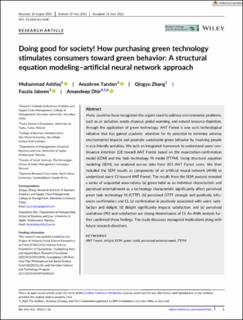| dc.contributor.author | Ashfaq, Muhammad | |
| dc.contributor.author | Tandon, Anushree | |
| dc.contributor.author | Zhang, Qingyu | |
| dc.contributor.author | Jabeen, Fauzia | |
| dc.contributor.author | Dhir, Amandeep | |
| dc.date.accessioned | 2023-03-29T11:53:23Z | |
| dc.date.available | 2023-03-29T11:53:23Z | |
| dc.date.created | 2022-09-26T14:08:11Z | |
| dc.date.issued | 2022 | |
| dc.identifier.citation | Ashfaq, M., Tandon, A., Zhang, Q., Jabeen, F., & Dhir, A. (2022). Doing good for society! How purchasing green technology stimulates consumers toward green behavior: A structural equation modeling–artificial neural network approach. Business Strategy and the Environment. | en_US |
| dc.identifier.issn | 0964-4733 | |
| dc.identifier.uri | https://hdl.handle.net/11250/3060900 | |
| dc.description.abstract | Many countries have recognized the urgent need to address environmental problems, such as air pollution, waste disposal, global warming, and natural resource depletion, through the application of green technology. ANT Forest is one such technological initiative that has gained academic attention for its potential to minimize adverse environmental impacts and promote sustainable green behavior by involving people in eco-friendly activities. We built an integrated framework to understand users' continuance intention (CI) toward ANT Forest based on the expectation-confirmation model (ECM) and the task–technology fit model (TTFM). Using structural equation modeling (SEM), we analyzed survey data from 353 ANT Forest users. We then included the SEM results as components of an artificial neural network (ANN) to understand users' CI toward ANT Forest. The results from the SEM analysis revealed a series of sequential associations: (a) green habit as an individual characteristic and perceived entertainment as a technology characteristic significantly affect perceived green task–technology fit (GTTF), (b) perceived GTTF strongly and positively influences confirmation and CI, (c) confirmation is positively associated with users' satisfaction and delight, (d) delight significantly impacts satisfaction, and (e) perceived usefulness (PU) and satisfaction are strong determinants of CI. An ANN analysis further confirmed these findings. The study discusses managerial implications along with future research directions. | en_US |
| dc.language.iso | eng | en_US |
| dc.publisher | Wiley | en_US |
| dc.rights | Navngivelse 4.0 Internasjonal | * |
| dc.rights.uri | http://creativecommons.org/licenses/by/4.0/deed.no | * |
| dc.title | Doing good for society! How purchasing green technology stimulates consumers toward green behavior: A structural equation modeling–artificial neural network approach | en_US |
| dc.type | Peer reviewed | en_US |
| dc.type | Journal article | en_US |
| dc.description.version | publishedVersion | en_US |
| dc.rights.holder | The authors | en_US |
| dc.subject.nsi | VDP::Samfunnsvitenskap: 200 | en_US |
| dc.source.pagenumber | 1-18 | en_US |
| dc.source.journal | Business Strategy and the Environment (BSE) | en_US |
| dc.identifier.doi | 10.1002/bse.3188 | |
| dc.identifier.cristin | 2055529 | |
| cristin.ispublished | true | |
| cristin.fulltext | original | |
| cristin.qualitycode | 1 | |

